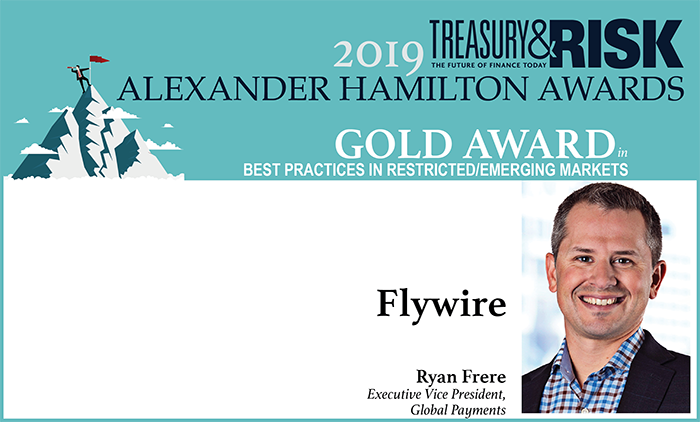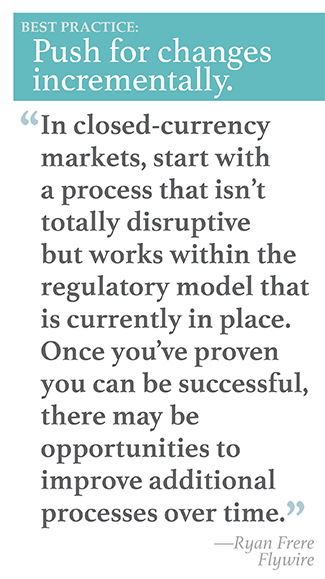
Boston-based vertical payments company Flywire was founded in2011 to help international students pay for their education. "Theinitial goal was to assist universities like MIT, for example, inreceiving tuition payments from markets all over the world," saysRyan Frere, the company's executive vice president of globalpayments. "Before Flywire existed, that was really challenging.What we've been able to do is streamline the cross-border paymentprocess from the receiver's perspective."
|Over the ensuing decade, Flywire's business has expanded beyondhigher ed to support the healthcare and travel industries as well.Geographically, the company now serves clients and their customersacross 220 countries and 150 currencies around the world, and hasprocessed over $12 billion in both cross-border and domestictransactions. Still, its primary objective remains the same: "Wework on behalf of our clients to make sure that their payers don'trun into challenges with some of life's most important payments,"Frere says.
|One market from which cross-border payments tend to bechallenging is India. That country has extensive documentationrequirements for residents who want to send fundsabroad—requirements that formerly presented a variety of hurdles inFlywire's attempts to facilitate aggregated internationalremittances. "India is second only to China in the number ofoutbound international students," Frere says, "but our processesfor supporting payments out of India used to be manual andoffline."
|Educational payments are an approved cross-currency funds flowfor the Reserve Bank of India (RBI), but the bank requires anapproval process to ensure that the rupees are being converted forthe right purposes. Flywire was providing an online funds-transferservice, but once Indian payers reached a certain point in theprocess, they would have to print an A2 ("Application for Drawal ofForeign Exchange") form and fill it out, providing detail about whythey needed to exchange rupees. Then they would have to deliver thephysical form to a Flywire partner organization within India, whichwould check the form for validity, file it away in case of audit bythe RBI, and complete the currency conversion.
|"The manual processes impacted the customer experience in threebig ways," Frere says. "There was the manual process of filling outthe form, which would sometimes take a payer days to completebecause they had to physically bring the form into one of thebranches of our partners. That was a hassle for payers, and itslowed down funds transfers."
|Second, the manual process had a significant impact on theFlywire customer support group. "We received as many calls as youmight anticipate," Frere reports. "Maybe a payer or their familyhad never before filled out an A2 form and needed assistance. Maybethey incorrectly answered some of the questions, which could besomewhat confusing."
|Then, in addition to the up-front calls, the process involvedmanual verification and follow-up on the back end to ensure thateverything looked right on the payer's A2 form. "Sometimes apayment would show up without the form filled out properly," Freresays. "Maybe the A2 form was missing, or maybe something seemedincorrect. The payment couldn't be released until the form wasverified, and often that required a back and forth with the payer.So that was a pretty heavy lift as well."
| Over the past few years, Indiahas been shifting toward allowing digital identification in meetingdifferent types of regulatory requirements. Flywire saw this trendas an opportunity to potentially streamline funds flows. "Throughour ongoing conversations with our partners in-market and our ownresearch, we were aware that India was moving toward a new, digitalapproach to gathering the information that the A2 form collected,"Frere says. "There was a strong push in-market to make theseprocesses more digital."
Over the past few years, Indiahas been shifting toward allowing digital identification in meetingdifferent types of regulatory requirements. Flywire saw this trendas an opportunity to potentially streamline funds flows. "Throughour ongoing conversations with our partners in-market and our ownresearch, we were aware that India was moving toward a new, digitalapproach to gathering the information that the A2 form collected,"Frere says. "There was a strong push in-market to make theseprocesses more digital."
The first step Flywire took was to partner with Deutsche Bank."Typically, when we are working with regulators on significantchanges like this—and we have done this in multiple markets acrossthe globe—we find it best to work closely with a financiallyregulated partner," Frere says. "We considered a number ofprospective banking partners. We found that when we presented toDeutsche Bank what we wanted to do, and how we expected theregulatory changes to play out, they were eager not only to help uscome up with a solution, but also to take our idea to RBI on ourbehalf.
|"Our case is much stronger if it's coming from a financialinstitution that is registered in-market than if it's coming fromus," Frere adds. "So we frequently pursue these types of jointconversations with central banks to get approval for our model. Andthat's how it worked in this case."
|Flywire and Deutsche Bank explained the Flywire operating modelto RBI regulators. After a year and a half of discussions, the RBIapproved of Flywire opening a Special Non-Resident Rupee (SNRR)account at Deutsche Bank. "The bank was able to make sure it wasset up in the right way because they had been part of the approvalprocess," Frere adds.
|Cross-border payers in India would still need to provide asignificant amount of information about their payments, but thedata could be collected electronically. Flywire worked withDeutsche Bank to ensure that its online form for requestingcross-border transactions out of India included all the data fieldsnecessary to complete a Liberalised Remittance Scheme (LRS)declaration form.
|Now that the system is functional, payers enter all the requiredinformation, along with their unique national permanent accountnumber (PAN) ID, via Flywire's online form. Because Flywire is nolonger relying on Indian partners to collect and validateinformation on paper forms, the company worked with an Indiantechnology provider to develop an automated digital process forconducting due diligence on payers. It uses the payer's PAN ID toconfirm that the other data on the form matches government records.When the payer's identity is validated, all the necessary dataflows automatically from Flywire into Deutsche Bank systems.
|"Since we can do this in real time, it accelerates paymentprocessing," Frere says. "We're also able to eliminate issues thatmight arise later on, saving time for both us and our payers. Whenwe send all this information through to Deutsche Bank, they canautomatically confirm that this is an approved payment, the rightperson, etc., in nearly real time."
|
See also:
|
In addition, Flywire worked with Deutsche Bank to develop avirtual account structure within its SNRR account. Each individualpayment has its own account number. "We create the payment and sendDeutsche Bank the necessary payment information, along with ourreconciliation details," Frere says. "The Deutsche Bank systemautomatically creates a virtual account and sends that accountnumber back to our system. That way, when the funds come back to usin the foreign currency, for us to send to our customerinstitution, it's a very easy reconciliation process because weknow which payer account the funds are coming from."
|Although the Flywire business model is somewhat unique, Frerethinks other organizations could learn from the company's approachto this project. "I think we do a good job of keeping a closeconnection to our clients and their payers, which helps usunderstand the pain points associated with these types oftransactions," he says. "Also, keeping an eye on regulation andmarket research in different regions is critical. As the regulatoryenvironment changes, you might find new ways in which you canimprove your operations through digital methods."
|To navigate regulatory changes, he advises other treasuryprofessionals to make sure they have strong counsel in each marketwhere they operate. "It's important to be comfortable withregulations yourself, but it's always good to get a second- orthird-party view on it," Frere says.
|Finally, he suggests approaching major projects incrementally."If we'd walked into the RBI up front, by ourselves, without a bankand said, 'We're going to take all this digital and online, as anAmerican offshore company,' I don't think the conversation wouldhave gone much past that point in time," Frere says. "Inclosed-currency markets, where there are a lot of controls on fundsflowing out, start with a process that isn't totally disruptive butworks within the regulatory model that is currently in place. Then,once you've proven that you can be successful in that model, theremay be opportunities to improve additional processes overtime."
|
Complete your profile to continue reading and get FREE access to Treasury & Risk, part of your ALM digital membership.
Your access to unlimited Treasury & Risk content isn’t changing.
Once you are an ALM digital member, you’ll receive:
- Critical Treasury & Risk information including in-depth analysis of treasury and finance best practices, case studies with corporate innovators, informative newsletters, educational webcasts and videos, and resources from industry leaders.
- Exclusive discounts on ALM and Treasury & Risk events.
- Access to other award-winning ALM websites including PropertyCasualty360.com and Law.com.
*May exclude premium content
Already have an account? Sign In
© 2024 ALM Global, LLC, All Rights Reserved. Request academic re-use from www.copyright.com. All other uses, submit a request to [email protected]. For more information visit Asset & Logo Licensing.







